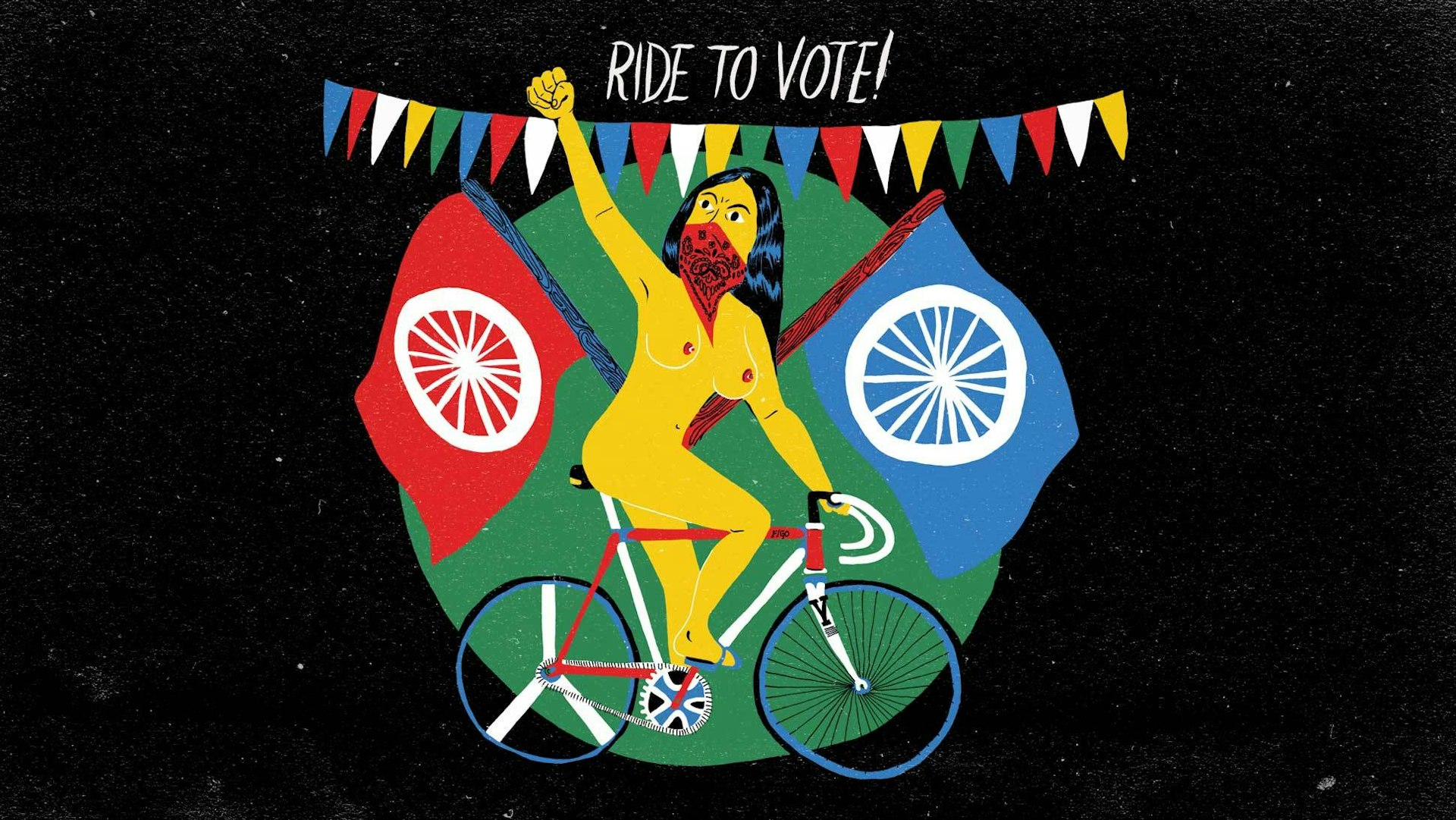
Radical Bikes
- Text by Olly Zanetti
- Illustrations by Stevie Gee
Campaigning against indecent exposure by parading in the nude might seem a little hypocritical. But it depends on your definition of ‘indecent exposure’. This year, prudish residents across seventy cities averted their eyes as the World Naked Bike Ride went by. Campaigning against everything from oil dependency to unrealistic body image norms, the ride’s organisers are clear about their definition of the term: “It’s time to put a stop to the indecent exposure of people and the planet to cars and the pollution they create,” they say on their website. In its relatively short history, the bicycle has become a machine for politics, as both a campaigning tool and a way to live out one’s political beliefs.
Which isn’t bad given that, less than 200 years ago, the idea of balancing on two wheels was considered physically impossible. Luckily, German inventor Baron Karl von Drais proved otherwise. And it all started with a giant cloud of ash. In 1815, the spectacular eruption of the Mount Tambora volcano in Indonesia spewed a cloud of ash so insipid and thick that it caused crops to fail below the world’s darkened skies. By 1816, there was barely enough food for people, let alone for horses used as transport. This predicament, suggests Robert Penn in his book It’s All About the Bike, was the mother of invention. By 1817, Drais was trialling his mechanical horse – aka the running machine or Draisine – which boasted a frame much like a modern bike, but without any pedals. Instead, the Draisine’s riders kept moving by kicking it along with their legs.
The next year, harvests returned to normal and the machine was all but forgotten. But development didn’t stop. First came the infamous Penny Farthing design, and the bike as we know it – with a chain, pedals, and two similarly sized wheels – came of age in the late 1800s. Suddenly, people could travel further, more quickly and using less energy, than every before. It was an instant hit.
“Let me tell you what I think of bicycling,” American suffragette Susan B Anthony told the New York Sunday World in 1896. “I think it has done more to emancipate women than anything else in the world.” At a time when Victorian values encouraged women to stay at home, the bike became a catalyst of change. Even those lucky enough to be married to enlightened men couldn’t get very far as social pressures forbade women from driving a horse and trap. But the bike was different. It was a key to independence; the saddle could only hold one person, and its very mobility forced riders to enter public space alone. The bike was new and the rules yet to be written, and women – from the middle classes at least – took to it in droves.
Soon enough, this new fangled machine was closing the gender gap in unexpected ways. In September 1893, a bold sixteen-year-old called Tessie Reynolds went on a bike ride that would, literally, help redress women’s rights. Not only did she cycle an unladylike 120 miles from Brighton to London and back again in a day, she did so wearing pantaloons and a shirt – a radical departure from the billowing dresses and unnaturally tight corsets of the time. Naked cyclists may provoke tutting in city centres today, but Tessie Reynolds’ feat caused outrage. The ride received widespread public attention, and was a coup for the so-called Rational Dress Movement who had long argued women should be free to wear practical clothes. Women today, it could be argued, owe their freedom to wear what they please at least in part to the bike.
As the 1900s began, the bike created the culture of everyday mobility that has remained. Cyclists, like those who led the Good Roads Movement in the States, became campaigners and demanded governments construct roads better suited to cycling. But this was also the time of Henry Ford – godfather of the mass-produced automobile. Bike sales began to slump, only picking up briefly during the 1970s oil crisis. Having shaken things up, the bike was superseded by the car. But that didn’t signal the end of its political story.
“The history of the bicycle can tell us a lot about the history of our world,” says Dr Dave Horton, a research associate at Lancaster University’s Environment Centre who’s working on a project to understand how people use walking and cycling as a mode of travel today. Horton has also penned several articles on the bike’s social history. “Something that was about the expansion of geographical, social and political horizons for the first half of its history, became, in the second half, the inverse of that, as things got too distant and too remote. That’s where anarchism and environmentalism take up the bike as a mode of mobility that could start to bring the world back down to a more local, convivial, face-to-face level.” The bike, having started life as a tool that helped forge modernity, switched faces and became a symbol of opposition to modernity’s excesses instead.
Drawing on that symbolism were Amsterdam-based anarchist collective Provo, who reached public attention in May 1965 with the launch of their ’zine of the same name. Their message was one of anti-consumerism in which the car came under fire because of the way it dominated the streets. “The asphalt terror of the motorised bourgeoisie has lasted long enough,” they proclaimed in an early poster. “Human sacrifices are made daily to this latest idol of the idiots: car power.” The Provo’s answer was the bicycle. Rather than encouraging people to buy bikes, however, they thought bikes should be freely available, unlocked around the city, for people to use whenever they needed.
On July 28, 1965, the public and media assembled for the presentation of the city’s first free bikes. The bikes were to be white, and at 3pm in the middle of a square in central Amsterdam, Provo activists began painting. In the weeks that followed, more bikes were dropped off around the city. The response from the authorities was bizarre. First the Provo were accused of obstructing traffic. Then many white bikes were impounded by police who argued that, left unlocked, they could get stolen. When the bikes were eventually returned, they were secured by combination locks with the codes painted on the bike’s frame. Though white bikes dropped off the agenda when Provo disbanded in 1967, the idea forms the basis of bike rental schemes, like the Parisian Vélib’, that are springing up across the world.
Bike-riding activists were amongst the demonstrators at last December’s climate change talks in Copenhagen too. Under the banner of the Bike Bloc, one group used bikes as a theatrical tool for protest and direct action. The Bike Bloc started life with a series of workshops run by the Laboratory of Insurrectionary Imagination at the Bristol art venue, the Arnolfini. Cadi, one of the activists, reflects on why she joined in: “I didn’t really feel that me just standing there in a protest was going to achieve anything. The Bike Bloc was exciting. It was constructive, not destructive, and it drew on all the things that are really good about cycling: being with your mates, being in a team, and that affinity you have with other cyclists.”
Day to day, the bike’s political struggle continues. Dangerous driving and bad infrastructure puts off many would-be cyclists, as documentary photographer-turned-filmmaker Richard Grassick shows in Beauty and the Bike. The film is set in Darlington, one of six demonstration towns in the UK where authorities are said to be improving conditions for cyclists. Grassick’s film has become a campaigning tool for groups the world over seeking the same thing.
Many, however, prefer to take their pro-cycling message straight to the street. The Critical Mass movement, which began as the Commute Clot in September 1992 in San Francisco, has spread to cities across the globe. Echoing the sentiment of groups like Provo, cyclists take to their bikes to challenge the car’s domination of the roads. According to critics, the ride’s aim is to block the roads, but that couldn’t be further from the truth. Critical Mass riders clump together so the riders collectively take over the streets; bikes aren’t blocking the traffic, they are the traffic, and they’re making a statement on their equal right of way. But as documents in the archives of South London’s radical social centre 56a show, the police don’t always get it – preferring, especially in the early years, to wade in and arrest participants. During Critical Mass, where speeding cars would normally push bikes into the gutter, roles are reversed and bikes regulate the car’s movements. With some bikes towing sound systems and riders in fancy dress, roaring traffic is replaced with a carnivalesque vibe – a vision of what cities could be like if streets weren’t cluttered with vehicles.
Over its short history, the bike has become symbolic of a better urbanism. It’s become a force of positive change. But to bring about more change, we need more two-wheeled activists reclaiming their rights to our roads. As sci-fi writer HG Wells once said, “Every time I see an adult on a bicycle, I no longer despair for the future of the human race.”
